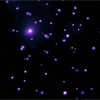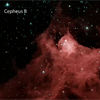CXC Home | Search | Help | Image Use Policy | Latest Images | Privacy | Accessibility | Glossary | Q&A
Tour of Cepheus B
Quicktime MPEG
A new study from two of NASA's "Great Observatories" provides fresh insight into how some stars are born, along with a beautiful new image of a stellar nursery in our own Milky Way Galaxy. While astronomers have long understood that stars and planets form from the collapse of a cloud of gas, the main causes of this process have remained mysterious. Now, research on an object known as Cepheus B, a cloud of hydrogen about 2400 light years from Earth, helps answer that question. X-rays seen by Chandra show where the young stars in the cloud are, while infrared emission observed by Spitzer reveals whether these stars contain planet-forming disks around them. Taken together, these data reveal that radiation from massive stars is triggering a new generation of stars to be born. This happens more often than previously thought.
[Runtime: 01:18]
Quicktime MPEG
A new study from two of NASA's "Great Observatories" provides fresh insight into how some stars are born, along with a beautiful new image of a stellar nursery in our own Milky Way Galaxy. While astronomers have long understood that stars and planets form from the collapse of a cloud of gas, the main causes of this process have remained mysterious. Now, research on an object known as Cepheus B, a cloud of hydrogen about 2400 light years from Earth, helps answer that question. X-rays seen by Chandra show where the young stars in the cloud are, while infrared emission observed by Spitzer reveals whether these stars contain planet-forming disks around them. Taken together, these data reveal that radiation from massive stars is triggering a new generation of stars to be born. This happens more often than previously thought.
[Runtime: 01:18]
(Credit: X-ray (NASA/CXC/PSU/K. Getman et al.); IR (NASA/JPL-Caltech/CfA/J. Wang et al.))
Chandra and Spitzer Images of Cepheus B
Quicktime MPEG
Astronomers observed an object known as Cepheus B, which is a cloud of molecular hydrogen about 2,400 light years from Earth. X-ray data from Chandra allowed the researchers to pick out the young stars within around Cepheus B. Infrared emission detected by Spitzer revealed whether the young stars had disks around them in which stars may form. By combining the two sets of data, astronomers found that stars in this object are being triggered to form by some external force, such as radiation from a massive star or a shock from a nearby supernova.
[Runtime: 00:08]
Quicktime MPEG
Astronomers observed an object known as Cepheus B, which is a cloud of molecular hydrogen about 2,400 light years from Earth. X-ray data from Chandra allowed the researchers to pick out the young stars within around Cepheus B. Infrared emission detected by Spitzer revealed whether the young stars had disks around them in which stars may form. By combining the two sets of data, astronomers found that stars in this object are being triggered to form by some external force, such as radiation from a massive star or a shock from a nearby supernova.
[Runtime: 00:08]
(Credit: X-ray (NASA/CXC/PSU/K. Getman et al.); IR (NASA/JPL-Caltech/CfA/J. Wang et al.))
Return to Cepheus B (August 12, 2009)




